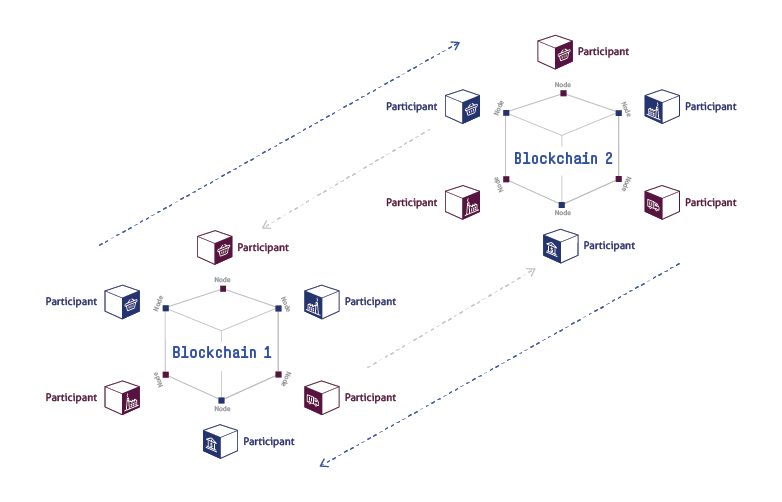How Blockchain Interoperability in Supply Chains Promotes Decentralization
Supply chains are inherently decentralized, where multiple participants come together to achieve a specific business outcome. It involves the delivery of either goods or services to the customer and receives ‘payment’ in exchange for value added to the customer. Simply put, supply chain visibility involves tracking all aspects of the supply chain, such as information, physical goods, and payments. All these aspects are inherently linked to each other. For example, once ‘physical goods’ are delivered to the customer’s doorstep, the ‘information’ about the delivery is confirmed via a three-way match – matching ordered vs. delivered vs. billed quantity before payments are processed.
Most of the supply chain exceptions come due to a mismatch in these aspects since they are processed in different systems belonging to the different supply chain participants.
Blockchain applications are increasingly being utilized to address these mismatches. Blockchains are decentralized networks that store tokens/information representing supply chain aspects on the distributed ledger. Multiple parties update the same ledger independently. Updates are governed by smart contracts, which are essentially a set of automated business rules validating and processing data. Due to the multi-party nature of the supply chains, there are possibilities emerging, where different blockchain applications address various aspects of the supply chains. That is where the concept of interoperability comes in. A blockchain does not have built-in integrations, either to the legacy ERP or other blockchains. The problem of communication between blockchains or other systems has led to a variety of cross-chain protocols, which can facilitate the exchange of data as well as tokens.
Blockchain interoperability can be defined as the capability of a blockchain to communicate with other blockchains so that it can read/write data in sync with the data residing in one of the blockchains. It can be envisaged as a single supply chain visibility application that can communicate with multiple blockchains, handling individual aspects such as provenance, payments, insurance, etc., via an isolated set of smart contracts deployed in the respective blockchains.
Blockchain interoperability is an important topic even for public blockchains since there are over 100 public blockchains at the moment, handling different cryptocurrencies having different technical approaches. While interoperability exists between Ethereum and Bitcoin, generalized interoperability protocols are emerging to help blockchains communicate via public or private blockchain infrastructure. Interoperability protocols are also important for integrating into legacy ERP systems since they need to build necessary integrations with public or private blockchains for large-scale adoptions.
Interoperability Among Blockchains

Blockchains in the enterprise space are emerging in private or consortium models. Private Blockchains are modeled for specific purposes, like visibility or provenance of goods, and are governed by a single company. Consortium Blockchains are where multiple parties come together to map specific business ecosystems, such as transportation or pharmaceutical supply chains and are governed by multiple parties via a consortium model. It is expected that many such models around enterprise blockchains will emerge, hence the need for exchanging data across different blockchains. It also warrants a discussion around governance, ownership, and commercial models as supply chain assets exchange across different blockchains.
Let us understand the concept of interoperability with an example from the Supply Chain domain.
A transportation provenance blockchain managed by a ‘private’ blockchain initiates a bill of lading, which represents the shipment of goods across the supply chain. The same document may be needed by the ‘consortium’ blockchain, managed by banks /insurers to process payments. So, any updates to the original bill of lading have to be communicated to the other blockchain instantly. Also, payment information may need to be sent to the ‘private’ blockchain managing transportation provenance.
Thus, interoperability is not just the capability to exchange data/tokens among blockchains but also keeping their ‘state’ and ‘uniqueness’ consistent, as if they were operating on a single blockchain. It’s the only way for supply chain participants to reap the benefits of adopting a blockchain around a shared ledger and tokenization.
Approaches to achieving interoperability
While physical supply chains involve reconciliation by intermediaries at each step of the process, digital supply chain assets represented on blockchains are not necessarily replicated as they move across different blockchains. Here are the different approaches for seamless integrations of supply chain assets across blockchains.
Digital asset exchange
Digital asset exchange across different blockchains is adopted from the approach followed on Public Blockchains. It is called atomic swaps/transfers that are complete only when both parties on the different blockchains, with publicly verifiable signatures, can complete their set of actions in their blockchains. It is used to make Bitcoin spendable on Ethereum applications. An issue with this approach is that it focuses only on the ‘asset/token’ exchange, representing supply chain assets, rather than the ‘event’ exchange. It may be possible that a ‘shipping’ event from the shipper’s blockchain can trigger the ‘creation’ of an asset in the Consignee’s Blockchain.
Arbitrary data exchange
Arbitrary data exchange allows the exchange of assets as well as events across blockchains, which can trigger a set of actions driven by smart contracts. It happens via a set of application programming interface (API) calls, which facilitates a multitude of functions, such as verification or trigger actions in response to the ‘source’ events. It also helps to create ‘same’ supply chain assets across blockchains tracked for different purposes, like bill of lading tracked for provenance on one and for payment on another.
Whether assets or event information is transferred across blockchains, it must be validated before being replicated into the ‘target’ blockchains. Some approaches involve the use of notary schemes, which is the same as having trusted parties confirm the authenticity of an asset/event before the transfer from one blockchain to another. Based on verification, the notary program can issue a signature, confirming all relevant details and signifying its acceptance of the transfer. Another approach is called ‘Relays,’ which is the ability to confirm directly with the ‘source’ supply chain before the acceptance of the asset. The relay approach can become increasingly complex, especially when different blockchains have different architectures/protocols of communication.
One of the popular approaches is the use of ‘Oracle’ – an agent that helps integrate not only with other blockchains but also with other legacy systems like ERPs. For example, before the transfer of the bill of lading to another Blockchain, you may want to validate the status of the bill of lading/shipment document in ERP. ‘Oracle’ agents get a confirmation from ERP systems on the status of the document and then facilitate transfers of assets/events across blockchains.
Benefits of blockchain interoperability in supply chains
Enables effective communication
It enables connection between two different blockchain networks for asset transfer, validation of transactions, and execution of contracts across networks. With the interoperability mechanism, the transaction is verified before the transfer, and is allowed to replicate only when the verification process is successful.
Discouraging centralization
Interoperability allows seamless communications across different blockchain networks. Hence, it may be feasible for the organization to launch multiple blockchain initiatives, targeting specific use cases, without worrying about escalating costs of integrations. This will reduce the centralization of platforms or blockchain initiatives. It helps to facilitate integrations via standardized protocols, helping all small/large blockchains to participate in the ecosystem.
Conclusion
Approaches towards interoperability are varied and require detailed analysis of protocols governing the blockchains involved. It also requires alignment in terms of business aspects, like governance/ownership of assets as they get transferred from one blockchain to another. LTIMindtree’s Blockchain COE is equipped with business and technical expertise to guide you through these advanced concepts in your blockchain implementation. Interoperability is recommended to be discussed right from the start of the implementation, as most of the blockchain initiatives are never stand-alone and require collaboration across multiple stakeholders. Our Blockchain COE can help with the architecture and implementation of advanced topics such as interoperability among Blockchains.
More from Sanket Kulkarni
With blockchain-based decentralized applications, the concept of tokenization has come into…
Latest Blogs
Introduction What if training powerful AI models didn’t have to be slow, expensive, or data-hungry?…
Pharmaceutical marketing has evolved significantly with digital platforms, but strict regulations…
Leveraging the right cloud technology with appropriate strategies can lead to significant cost…
Introduction The financial industry drives the global economy, but its exposure to risks has…




